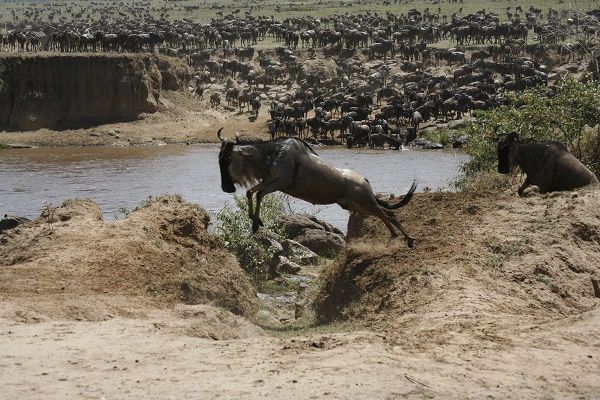Dream Trips: Catching the Migration in Kenya
Two-by-two, the wildebeest come in a seemingly endless line of gray that cuts through the Masai Mara's golden plains. The wildebeest and their migrating companions, the zebra, move toward the Mara River. Hundreds upon hundreds of animals mass on the savannah just above the river bank, braying as they push into already crowded circles. The air is thick with expectation.

Two-by-two, the wildebeest come in a seemingly endless line of gray that cuts through the Masai Mara’s golden plains. The wildebeest and their migrating companions, the zebra, move toward the Mara River. Hundreds upon hundreds of animals mass on the savannah just above the river bank, braying as they push into already crowded circles. The air is thick with expectation.
Everyone waits. Watching from our Land Cruiser on the river bank opposite the animals, my daughter Alissa and I finish our lunch of sandwiches and cookies. Wisely, James Massek, our ranger guide from & Beyond’s sister camps in Kenya, Kichewa Tembo and Bateleur, suggest we opt for a day-long drive so that we could travel far enough to catch the migration. Bateleur packs a picnic for us.
Catching a river crossing is part science and part luck. Timing is key. The migration to the high grass of Kenya from Tanzania’s Serengeti takes place July-October and the journey back starts around December-January, after the herds have grazed the plains’ red oat grass to stubble. But the schedule varies depending on the rain and the animals. That’s why & Beyond advises us to book lodgings in both Kenya and in Tanzania at Klein’s Camp not far from Kenya’s border.
James, a Masai tribe member, drives us to a narrow bend in the river near the Kiboko camps, a place the herds have crossed in prior years. We watch as first one wildebeest and then another and then more come down to the river to drink and to sniff before returning up the bank.
Finally, one wildebeest leaps into the water. In the next second, the animals braying loudly jump into the river, kicking up a swirl of dust and river spray. A few get picked off by the 10-foot crocodiles patiently waiting in the water, but most of the wildebeest and zebras swim to safety, trotting up the river bank, their backs slick and shiny in the African sun.
A safari always rewards. Witnessing the migration of 1.5 million wildebeest accompanied by 500,000 zebras is amazing.
& Beyond, www.andbeyond.com
​Photos copyright Alissa Kempler.
